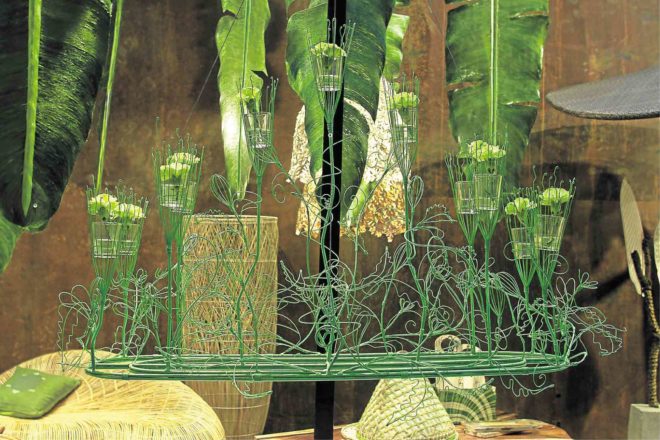
Basket-weave bird cages were used as magazine trays; heads of santo were emboldened with color and graphics; mops of straws were turned into pouf chairs. Oversized paper fans were shaped into room dividers.
Despite the dwindling attendance in design trade shows worldwide, the 67th edition of the Manila FAME remained ebullient with innovative yet salable products.
The crux of the trade show was the Design Commune, the central setting consisting of home accessories crafted by micro, small and medium enterprises and manufacturers from all over the Philippines.
Creative director and product development program lead Tony Gonzales chose the mainstream setting, focusing on lifestyles. He said that if manufacturers were willing to produce bigger volumes of the designs, they could get their returns since the styles were designed for market appeal.
The designers behind the Design Commune included Josef Crisanto, mentor of the New Design Graduate Training Program of the Design Center Philippines (DCP); Tes Pasola; German consultant Detlef Klatt; and Reine Shih, who works for Gonzales.
Monochromatic blue
The most notable trend was the monochromatic blue scheme. Designers worldwide have been pairing various shades of blue instead of combining it with contrasting colors as in past seasons.
Among the standouts were the denim nesting tables, adorned with wire patterns inspired by the spirograph, and Pasola’s drawer made of thrift-shop denim ribbons. The drawer won the Katha Product of the Year for recycling scraps into a functional item. The intricate intertwining of the denim made it permeable. Hence, it won’t attract molds.
Gonzales also noted the trend in naturals or the use of organic or plant-based materials such as sofas from arurog and lighting fixtures fashioned from rope and beads. The style was a response to the trend of bringing the outdoors inside.
A garden setting was enlivened with abaca banana leaves, abaca and wire chandeliers with floral and figurative designs, and faux hanging plants that could serve as vases.
The Naturals setting also devoted a space for metallics that added luster and texture to the show.
The theme of travel as interpreted in the Ethnic Nomads setting featured geometric patterns, but done in shades for both summer and autumn.
On trends, Klatt observed that the international market appreciates sustainable, handmade products with a narrative.
“When you talk of trend it could refer to a style and color. Trend is also about feeling. People are looking for a story, just something nice,” he said. “You learn about the process in each fiber. This adds value to the product, as compared with something that is mass-produced.”
Free of charge
Unlike in previous shows where manufacturers paid designers P20,000 to P50,000 to design new products in time for the trade show, Gonzales and Crisanto guided 86 companies free of charge.
“We felt everybody needed a shot in the arm,” Gonzales said.
“Let us help each other make the show healthy again,” Pasola rejoined. “Some exhibitors said no buyers were coming. On the other hand, buyers said, why will we go if there are no exhibitors? I tell them it’s not a chicken-and-egg thing. Let’s help by attending the show, presenting the buyers with good products, and making the prices reasonable.”
The local manufacturers learned to make use of common things in new ways. Straw, for instance, suggested the feel of a shag pile rug. The bird cages sold outside the churches were made into a pet bed. Scraps from tree trunks were cut into coasters with a fashionable aqua lining. Shells were carved into insect-shaped coasters and trays. Buri or tingting was shaped into curvaceous vases.
“I find the show optimistic. It’s not austere or too designed. The feel is fun, at times there is some naiveté in the products,” Crisanto said. He pointed out how simple materials and basic techniques lent character. For instance, the scraps for bath mats and potholders wove color into bird-cage trays. Leather saddle stitches on wooden plates gave them a graphic edge.
“This is a happy exhibition unlike the previous exhibitions where the lines were too clean or the styles were Italian looking,” he added.
Klatt’s wish is for the Filipino manufacturers to think global where the market potential is bigger. They were comfortable in selling a few quantities for the local market but with higher profit margins. Klatt said that producing for the international market would have a ripple effect on the economy.
“Filipinos have many stories on how the product is made and where it comes from. It’s important to work together and present everything in one story. Although there is a direction, manufacturers are concentrated on the local market. They can accomplish more if they cater to (markets) outside of the Philippines.”–CONTRIBUTED